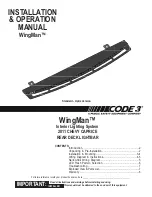
−
−
−
−
−
−
The following factors can lower your
vehicle’s fuel economy:
Idling
results in 0 miles per gallon (0 kms
per liter).
Aerodynamic drag has a big effect
on fuel economy at speeds above
45 mph (75 km/h). Reduce your
speed and you reduce the drag.
Trailers, car top carriers, roof
racks and bike racks are also big
contributors to increased drag.
Rapid
acceleration, abrupt cornering,
and hard braking increase fuel
consumption.
In
particular, a build-up of snow or
mud on your vehicle’s underside
adds weight and rolling resistance.
Frequent cleaning helps your fuel
economy.
It puts a heavier
load on the engine, increasing fuel
consumption.
An underinflated tire increases
‘‘rolling resistance,’’ which reduces
fuel economy.
A properly maintained vehicle
maximizes fuel economy. Poor
maintenance can significantly reduce
fuel economy. Always maintain your
vehicle according to the maintenance
messages displayed on the multi-
information display (see
on page
).
For example:
Improperly inflated tires
Driving with a heavy load or the
air conditioner running
Cold engine operation (engines
are more efficient when warmed
up)
Excessive idling, accelerating and
braking in stop-and-go traffic
Aggressive driving (hard
acceleration and braking)
452
CONTINUED
Fuel Economy
Fuel Economy Factors
Avoid excessive idling
Observe the speed limit
Drive moderately
Keep your vehicle clean
Avoid carrying excess weight in
your vehicle
Maintain proper tire inf lation
Use the recommended viscosity
motor oil, displaying the API
Certif ication Seal (see page
).
Owner’s
Maintenance Checks
Improving Fuel Economy
458
Drive Ef f iciently
Vehicle Maintenance
B
e
fo
re
D
riv
ing
389
11/07/20 18:51:31 31SJA670_394
Summary of Contents for 2012 RL
Page 6: ...11 07 20 17 59 21 31SJA670_005 ...
Page 8: ...2 11 07 20 17 59 34 31SJA670_007 ...
Page 12: ...6 11 07 20 18 00 10 31SJA670_011 ...
Page 208: ...202 11 07 20 18 25 50 31SJA670_207 ...
Page 404: ...398 11 07 20 18 52 40 31SJA670_403 ...
















































